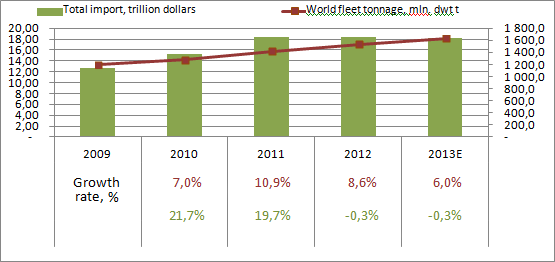Excess of World Transport Fleet
26.05.2014
The tonnage of the world commercial fleet in 2013 reached the figure of 1 629 million tons. The growth of the world fleet is influenced by globalization and expansion of the world commerce; however, experts believe that increasing of the world fleet is in advance of the demand for its services. The world economy grows with low rates, while the total import volumes have even decreased in the recent two years.
Schedule 1. Dynamics of the total world import and commercial fleet tonnage in 2009-2013

Source: UNCTAD, International Trade Centre
Among factors which negatively affect development of marine transport, one can name economic uncertainty, limited character of trade financing, marine piracy and geopolitical tension, as well as trade barriers, dynamics of direct foreign investment and infrastructure development.
Excess of commercial fleet is explained by commissioning of a large number of new vessels, the peak of which was observed in 2008, when the world fleet was enlarged by 3 748 vessels, with the total tonnage of 96.4 mln tons, 45% of which was the share of bulkers, 28% - of tankers and 15% - of container ships. The situation became worse following the crisis, in 2011-2012.
In the structure of the world transport fleet the dominant part is taken by oil tankers and dry cargo ships, the share of which, by results of 2013, amounted to three quarters of the total tonnage. One should note that the share of tankers gradually decreases: in 1980 they made up a half of the total tonnage, in 2005 – 38%, in 2013 – as little as 30%. The share of bulkers, on the opposite, increased: from 2005 to 2013 it increased by 6 percentage points from 36 to 42%.
The decrease of the share of oil tankers in the total structure was accompanied by tonnage excess, which could not be compensated even by a significant growth of oil import to China. The highest excess of offer was observed among the largest VLCC tankers. A downturn in retail trade and construction caused by the crisis, first of all, reflected on dry cargo ships and container ships.
One should note that in recent years there have appeared some new types of marine ships: ro-ro vessels for transport of vehicles and people, vehicle transporters, liquefied natural and oil gas transporters, besides, there have appeared combined vessels that make it possible to transport various kinds of cargo on the same vessel. However, the new types of vessels still cannot find a proper place in the total structure.
Growing fuel prices reduced profitability of marine transportation, due to which the main task of ship-building was reduction of power consumption of vessels and increasing of fuel efficiency. Besides, work in the given direction is determined by adoption of international ecological standards.
For more information, please, see “Market of Marine and River Cargo Transportation: Comprehensive Analysis and Forecast till 2016” by Intesco Research Group.
The given figures were calculated by analysts of Intesco Research Group based on official statistics.

